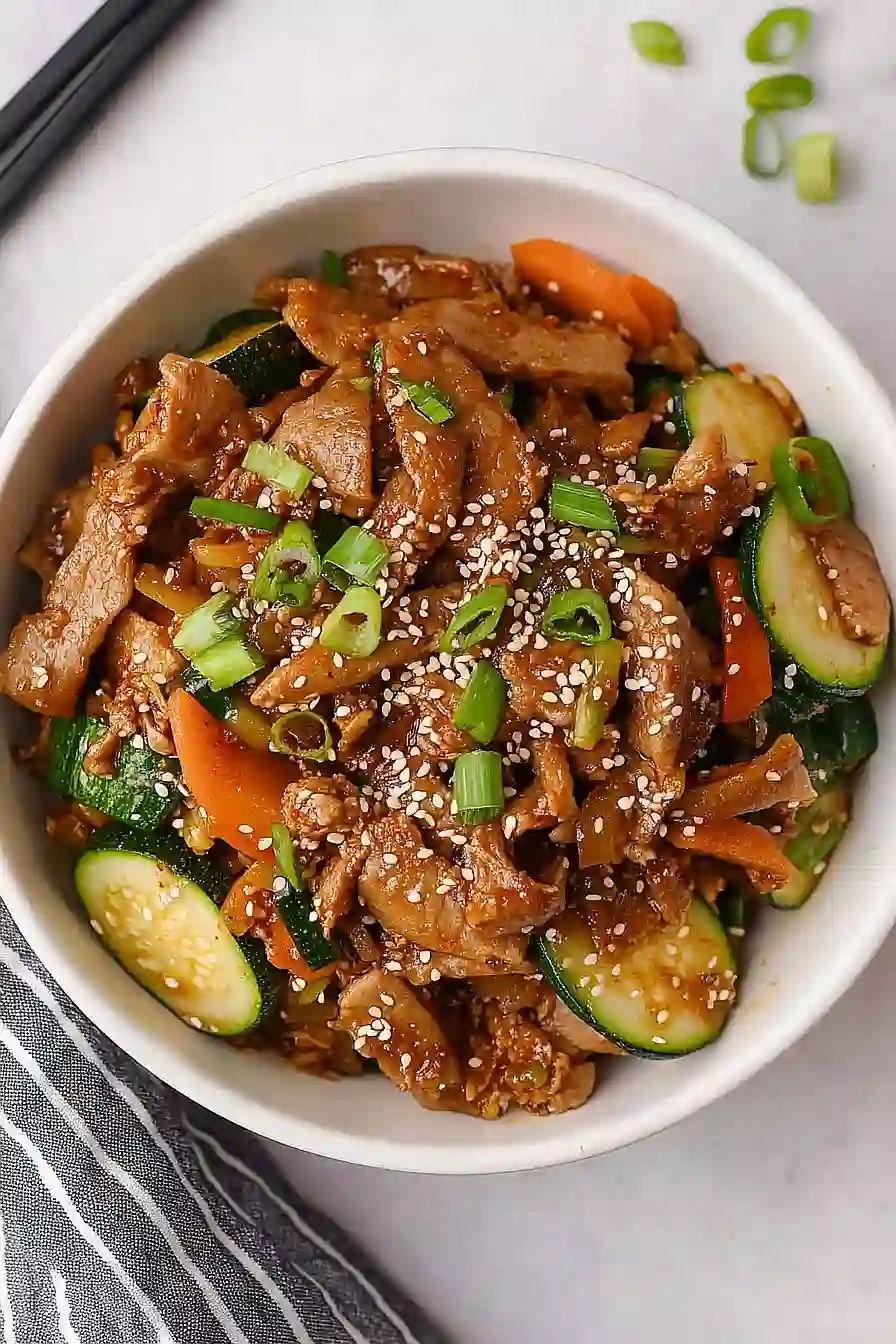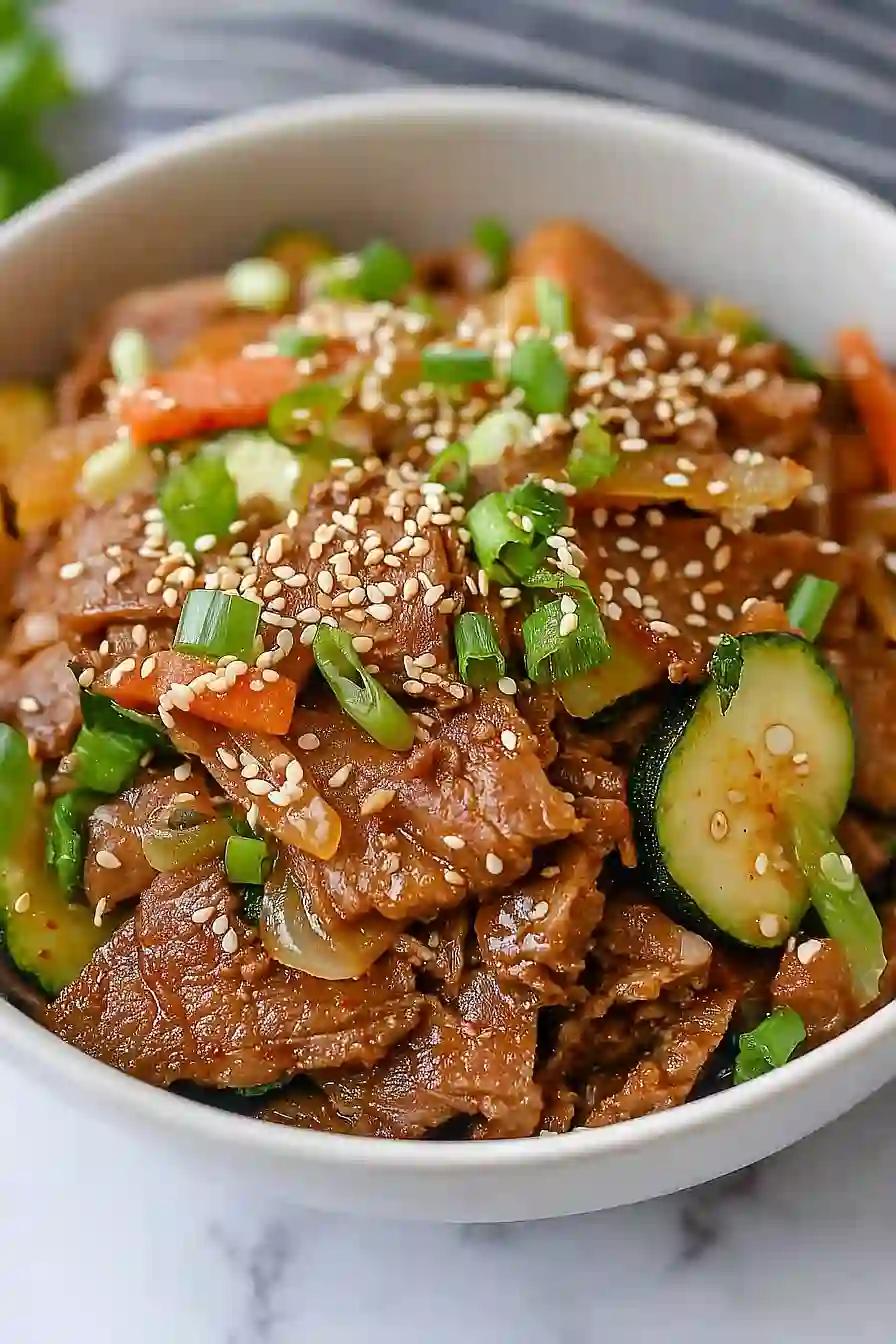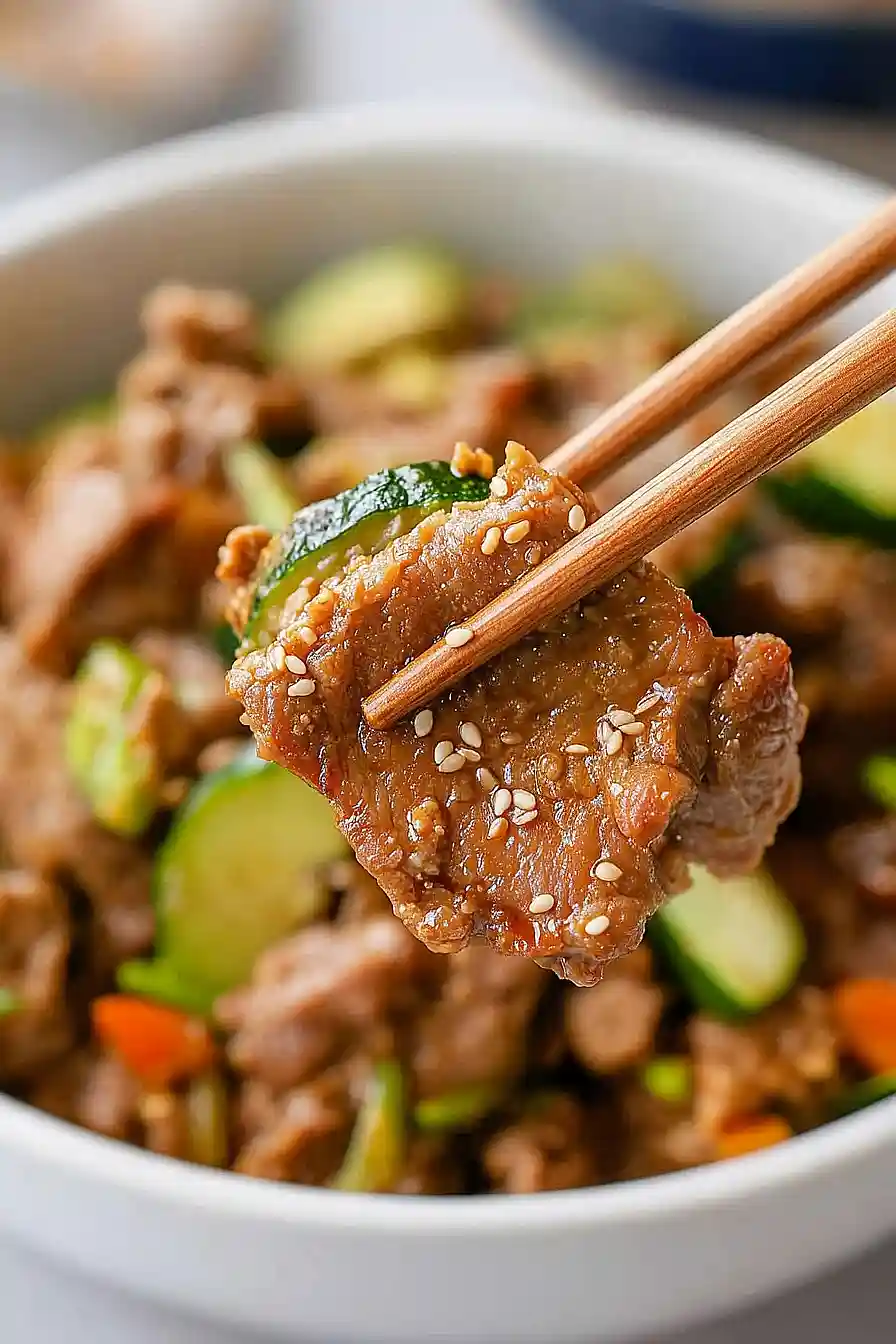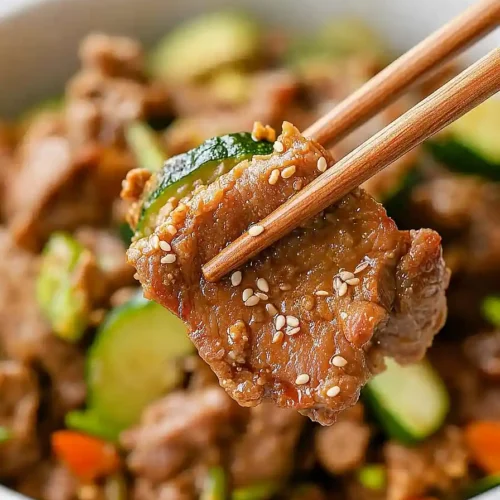Here is my favorite Korean pork tenderloin recipe, with a simple marinade made from soy sauce, ginger, garlic, sesame oil, and a touch of honey that creates a sweet and savory glaze.
This Korean pork tenderloin has become our go-to weeknight dinner when we want something that feels special but doesn’t take forever to make. I love that it only needs about 30 minutes of marinating time, and the leftovers make great sandwich meat for lunch the next day.

Why You’ll Love This Korean Pork Tenderloin
- Quick weeknight dinner – Ready in under an hour, this dish is perfect for busy evenings when you want something flavorful without spending all night in the kitchen.
- Diet-friendly options – This recipe works for paleo, AIP, and gluten-free diets, with easy modifications to suit your needs.
- Restaurant-quality flavor at home – The combination of coconut aminos, ginger, garlic, and Korean chili flakes creates that authentic Korean taste you’d get at your favorite restaurant.
- Packed with vegetables – Carrots, zucchini, and onions cook right alongside the pork, giving you a complete, balanced meal in one pan.
- Customizable spice level – You can easily adjust the heat by adding more or less gochugaru, or skip it entirely for a mild version the whole family will enjoy.
What Kind of Pork Should I Use?
This recipe works great with either pork tenderloin or pork shoulder, depending on what you prefer. Pork tenderloin is leaner and cooks faster, making it perfect for a quick weeknight meal, while pork shoulder has more fat and will give you a juicier, more tender result. If you go with pork shoulder, make sure to slice it thinly against the grain so it stays tender and absorbs all that delicious marinade. You can usually find both cuts at your local grocery store, and if you’re short on time, some stores even sell pre-sliced pork that’s ready to go.

Options for Substitutions
This Korean pork recipe is pretty forgiving when it comes to swaps:
- Pork tenderloin: The recipe already mentions pork shoulder as an option, which works great. You can also use boneless pork chops sliced thin, or even chicken thighs if you prefer poultry. Just adjust cooking time accordingly – chicken will cook faster than pork.
- Coconut aminos: If you’re not following a special diet, regular soy sauce or tamari works perfectly here. Use the same amount, though you might want to add a tiny splash of water since soy sauce is saltier.
- Korean chili flakes (gochugaru): Can’t find gochugaru? Try red pepper flakes, but use about half the amount since they’re spicier. For a milder version, paprika gives color without much heat.
- Apple: The apple adds natural sweetness and helps tenderize the meat. You can swap it with Asian pear (traditional in Korean cooking), or use 1-2 tablespoons of honey or maple syrup instead.
- Sesame oil: If you don’t have sesame oil, you can skip it or add a bit more avocado oil. The flavor won’t be quite as authentic, but it’ll still taste good.
- Vegetables: Feel free to mix up the veggies based on what you have. Bell peppers, mushrooms, snap peas, or cabbage all work nicely in this dish.
Watch Out for These Mistakes While Cooking
The biggest mistake when cooking pork tenderloin is overcooking it, which turns this naturally lean cut dry and tough – aim for an internal temperature of 145°F and let it rest for 5 minutes, as the carryover heat will finish the job while keeping it juicy.
Another common error is not slicing the pork against the grain after cooking, which makes even perfectly cooked meat seem chewy, so look for the direction of the muscle fibers and cut perpendicular to them for tender bites.
If you’re marinating the pork, don’t go longer than 4-6 hours since the coconut aminos can break down the meat too much and create a mushy texture.
For the vegetables, add them to the pan in stages based on cooking time – carrots first since they take longer, then zucchini near the end – so everything finishes at the same time without turning mushy.

What to Serve With Korean Pork Tenderloin?
This Korean pork is perfect served over a big bowl of steamed white or brown rice to soak up all that delicious sauce. I love adding some quick pickled cucumbers or kimchi on the side for a tangy crunch that balances out the savory flavors. If you want to make it more of a complete meal, try serving it with some sautéed bok choy or a simple cucumber salad dressed with rice vinegar and a touch of sesame oil. For a fun twist, you can also wrap the pork and veggies in butter lettuce leaves for a lighter, hands-on dinner that everyone can build themselves.
Storage Instructions
Store: This Korean pork keeps really well in the fridge for up to 4 days in an airtight container. The flavors actually get even better as they sit together, so it’s great for meal prep. I like to portion it out with some cauliflower rice for easy grab-and-go lunches throughout the week.
Freeze: You can freeze the cooked pork for up to 3 months in a freezer-safe container or bag. Just make sure it’s cooled completely first. The vegetables might be a bit softer after freezing, but the pork itself holds up great and the flavor stays delicious.
Reheat: Warm it up in a skillet over medium heat with a splash of water or broth to keep it from drying out. You can also microwave it, but I find the stovetop method keeps the texture better. Either way, just heat until it’s warmed through and you’re good to go.
| Preparation Time | 10-15 minutes |
| Cooking Time | 15-20 minutes |
| Total Time | 55-65 minutes |
| Level of Difficulty | Medium |
Estimated Nutrition
Estimated nutrition for the whole recipe (without optional ingredients):
- Calories: 800-900
- Protein: 65-75 g
- Fat: 40-50 g
- Carbohydrates: 35-45 g
Ingredients
For the marinade and pork:
- 1 lb pork tenderloin or pork shoulder, thinly sliced
- 1/3 cup coconut aminos
- 1/2 tsp sea salt, plus more as needed
- 1 tbsp sesame oil (omit for aip)
- 2 tsp gochugaru (korean chili flakes; optional, omit for aip)
- 3 garlic cloves
- 1 inch piece fresh ginger
- 1/4 apple, chopped (use 1/2 for more sweetness)
For stir-frying:
- 1 medium onion, sliced
- 1 carrot, thinly sliced
- 1/2 zucchini, cut into half moons
- 2–3 tbsp avocado oil or another cooking oil
For garnish:
- Chopped green onions
- Sesame seeds (omit for aip)
Step 1: Prepare the Pork Marinade
- 1 lb pork tenderloin or pork shoulder, thinly sliced
- 1/3 cup coconut aminos
- 1/2 tsp sea salt, plus more as needed
- 1 tbsp sesame oil (omit for AIP)
- 2 tsp gochugaru (Korean chili flakes; optional, omit for AIP)
- 3 garlic cloves
- 1 inch piece fresh ginger
- 1/4 apple, chopped
Place the thinly sliced pork in a resealable bag or glass container.
In a blender, combine the coconut aminos, sea salt, sesame oil, gochugaru (if using), garlic cloves, ginger, and chopped apple.
Blend the mixture until smooth.
Pour the marinade over the pork, toss well to coat, then cover and let it marinate for at least 30 minutes at room temperature or longer in the refrigerator for deeper flavor.
Step 2: Cook the Marinated Pork
- marinated pork from Step 1
- saved marinade from Step 1
- 2–3 tbsp avocado oil or another cooking oil
Drain the marinated pork, being sure to save the marinade for later.
Heat 1 tablespoon of avocado oil (or another cooking oil) in a large skillet over medium-high heat until sizzling hot.
Working in batches, add the pork to the pan in a single layer and sear for about 2 minutes per side.
Add more oil as needed for additional batches.
Once cooked, remove the meat and set aside in a bowl.
Step 3: Sauté the Vegetables
- 1 medium onion, sliced
- 1 carrot, thinly sliced
- 1/2 zucchini, cut into half moons
- additional avocado oil or another cooking oil, as needed
Add another tablespoon of oil to the same skillet if needed.
Add the sliced onion, thinly sliced carrot, and zucchini half moons.
Stir and cook for 3-5 minutes, or until the vegetables are just crunchy-tender.
This step keeps the veggies vibrant and gives texture to the dish.
Step 4: Combine Pork, Veggies, and Marinade
- cooked pork from Step 2
- saved marinade from Step 1
- sautéed vegetables from Step 3
Return the cooked pork from Step 2 to the skillet with the sautéed vegetables.
Pour in the reserved marinade and cook, stirring, for about 1 minute until the meat is heated through and the marinade is bubbling.
Taste and add more sea salt if needed.
I often add a splash more coconut aminos at this point if I want a deeper umami kick.
Step 5: Garnish and Serve
- chopped green onions
- sesame seeds (omit for AIP)
Serve the pork and vegetable stir-fry warm, with rice or cauliflower rice if desired.
Top generously with chopped green onions and sesame seeds for flavor and crunch.
For a more authentic flavor, I like to use plenty of fresh green onion just before serving.

Tender Korean Pork Tenderloin
Ingredients
For the marinade and pork:
- 1 lb pork tenderloin or pork shoulder, thinly sliced
- 1/3 cup coconut aminos
- 1/2 tsp sea salt, plus more as needed
- 1 tbsp sesame oil (omit for AIP)
- 2 tsp gochugaru (Korean chili flakes; optional, omit for AIP)
- 3 garlic cloves
- 1 inch piece fresh ginger
- 1/4 apple, chopped (use 1/2 for more sweetness)
For stir-frying:
- 1 medium onion, sliced
- 1 carrot, thinly sliced
- 1/2 zucchini, cut into half moons
- 2–3 tbsp avocado oil or another cooking oil
For garnish:
- chopped green onions
- sesame seeds (omit for AIP)
Instructions
- Place the thinly sliced pork in a resealable bag or glass container. In a blender, combine the coconut aminos, sea salt, sesame oil, gochugaru (if using), garlic cloves, ginger, and chopped apple. Blend the mixture until smooth. Pour the marinade over the pork, toss well to coat, then cover and let it marinate for at least 30 minutes at room temperature or longer in the refrigerator for deeper flavor.
- Drain the marinated pork, being sure to save the marinade for later. Heat 1 tablespoon of avocado oil (or another cooking oil) in a large skillet over medium-high heat until sizzling hot. Working in batches, add the pork to the pan in a single layer and sear for about 2 minutes per side. Add more oil as needed for additional batches. Once cooked, remove the meat and set aside in a bowl.
- Add another tablespoon of oil to the same skillet if needed. Add the sliced onion, thinly sliced carrot, and zucchini half moons. Stir and cook for 3-5 minutes, or until the vegetables are just crunchy-tender. This step keeps the veggies vibrant and gives texture to the dish.
- Return the cooked pork from Step 2 to the skillet with the sautéed vegetables. Pour in the reserved marinade and cook, stirring, for about 1 minute until the meat is heated through and the marinade is bubbling. Taste and add more sea salt if needed. I often add a splash more coconut aminos at this point if I want a deeper umami kick.
- Serve the pork and vegetable stir-fry warm, with rice or cauliflower rice if desired. Top generously with chopped green onions and sesame seeds for flavor and crunch. For a more authentic flavor, I like to use plenty of fresh green onion just before serving.

